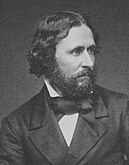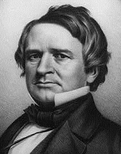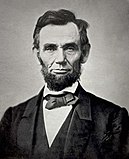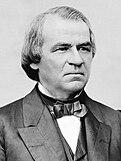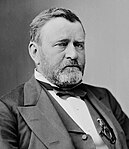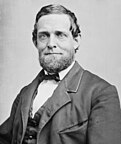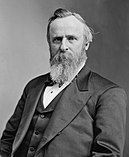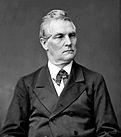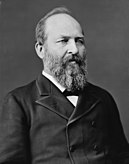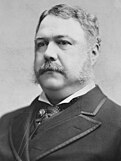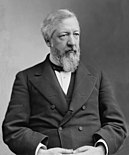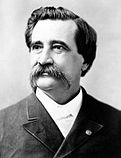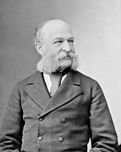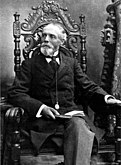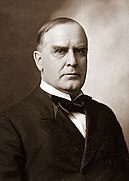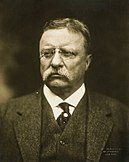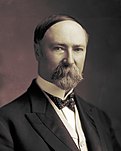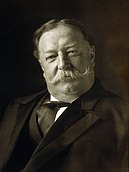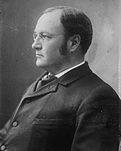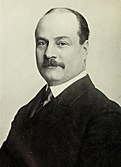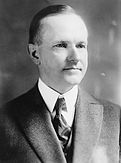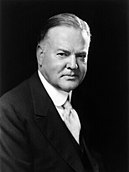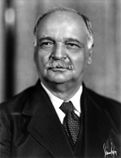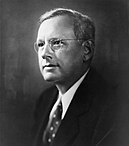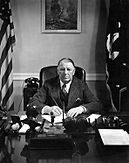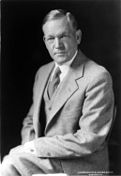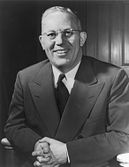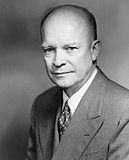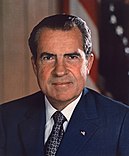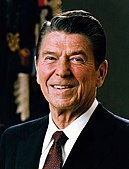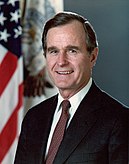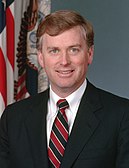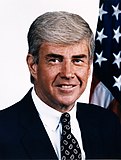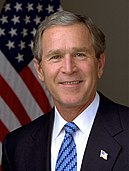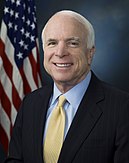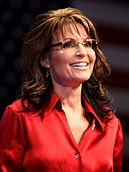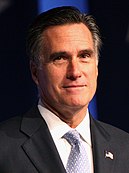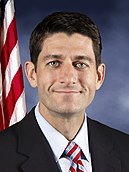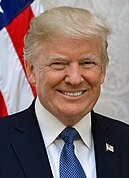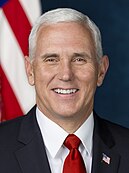Wikipedia list article
This is a list of the candidates for the offices of President of the United States and Vice President of the United States of the Republican Party , either duly preselected and nominated, or the presumptive nominees of a future preselection and election. Opponents who received over one percent of the popular vote or ran an official campaign that received Electoral College votes are listed. Offices held prior to Election Day are included, and those held on Election Day have an italicized end date.
19th century [ ] 1856 [ ]
Presidential
1856 (lost)Vice Presidential
John C. Frémont CA
Prior public experience Higher education
Prior public experience Associate Justice of the New Jersey Supreme Court (1838–1841)
U.S. Senate (1842–1851)
Higher education Princeton University (BA )
William L. Dayton NJ
Opponent(s) James Buchanan (Democratic )Millard Fillmore (Know Nothing )
Electoral vote Buchanan/Breckinridge: 174 (58.8%) Frémont/Dayton: 114 (38.5%)
Fillmore/Donelson: 8 (2.7%) Popular vote
Buchanan/Breckinridge: 1,836,072 (45.3%) Frémont/Dayton: 1,342,345 (33.1%)
Fillmore/Donelson: 873,053 (21.5%)
Opponent(s) John Breckinridge (Democratic )Andrew Jackson Donelson (Know Nothing )
1860, 1864 [ ]
Presidential
1860 (won), 1864 (won)Vice Presidential
Abraham Lincoln IL
Prior public experience Illinois House of Representatives (1834–1842)U.S. House of Representatives (1847–1849)President (1861–1865 )Higher education
Prior public experience Maine House of Representatives (1836–1841, 1847)
U.S. House of Representatives (1843–1847)
U.S. Senate (1848–1857, 1857–1861 )
Chair of the Senate Commerce Committee (1849–1856)
Chair of the Senate Printing Committee (1852–1853) Governor of Maine (1857)Higher education
Hannibal Hamlin ME
Prior public experience Tennessee House of Representatives (1835–1837, 1839–1841)Tennessee Senate (1841–1843)U.S. House of Representatives (1843–1853)
Chair of the House Public Expenditures Committee (1849–1852) Governor of Tennessee (1853–1857, 1862–1865 )U.S. Senate (1857–1862)
Higher education
Andrew Johnson TN
Opponent(s) Stephen Douglas (Democratic )John C. Breckinridge (Southern Democrats )John Bell (Constitutional Union )
Electoral vote Lincoln/Hamlin: 180 (59.4%) Breckinridge/Lane: 72 (23.8%)
Bell/Everett: 39 (12.9%)
Douglas/Johnson: 12 (4.0%) Popular vote Lincoln/Hamlin: 1,865,908 (39.7%) Douglas/Johnson: 1,380,202 (29.5%)
Breckinridge/Lane: 848,019 (18.2%)
Bell/Everett: 590,901 (12.7%)
Opponent(s) Herschel Johnson (Democratic )Joe Lane (Southern Democrats )Edward Everett (Constitutional Union )
Opponent(s) George McClellan (Democratic )
Electoral vote Lincoln/Johnson: 212 (91.0%) [1] McClellan/Pendleton: 21 (9.0%)[2] Popular vote
Lincoln/Johnson: 2,218,388 (55.0%) McClellan/Pendleton: 1,812,807 (45.0%)
Opponent(s) George Pendleton (Democratic )
1868, 1872 [ ]
Presidential
1868 (won), 1872 (won)Vice Presidential
Ulysses Grant OH
Prior public experience Higher education U.S. Military Academy (BS )
Prior public experience U.S. House of Representatives (1855–1869 )
Higher education
Schuyler Colfax IN
Prior public experience Massachusetts House of Representatives (1841–1842)Massachusetts Senate (1844–1846, 1850–1852)
U.S. Senate (1855–1873 )
Higher education
Henry Wilson MA
Opponent(s) Horatio Seymour (Democratic )
Electoral vote Grant/Colfax: 214 (72.8%) Seymour/Blair: 80 (27.2%) Popular vote Grant/Colfax: 3,013,421 (52.7%) Seymour/Blair: 2,706,829 (47.3%)
Opponent(s) Francis Blair (Democratic )
Opponent(s) Horace Greeley (Democratic )
Electoral vote Grant/Wilson: 286 (81.3%) [3] Greeley/Brown: 66 (18.8%)*[4] [5] Popular vote
Grant/Wilson: 3,598,235 (55.6%) Greely/Brown: 2,834,761 (43.8%)
Opponent(s) Gratz Brown (Democratic )
1876 [ ]
Presidential
1876 (won)Vice Presidential
Rutherford Hayes OH
Prior public experience U.S. House of Representatives (1865–1867)Governor of Ohio (1868–1872, 1876–1877 )Higher education Kenyon College (BA )Harvard University (LLB )
Prior public experience New York Assembly (1850–1851)New York Senate (1858–1859)U.S. House of Representatives (1861–1877 )
Higher education University of Vermont (BA )
William Wheeler NY
Opponent(s) Samuel Tilden (Democratic )
Electoral vote Hayes/Wheeler: 185 (50.1%) Tilden/Hendricks: 184 (49.9%) Popular vote
Tilden/Hendricks: 4,288,546 (50.9%) Hayes/Wheeler: 4,034,311 (47.9%)
Opponent(s) Thomas Hendricks (Democratic )
1880 [ ]
Presidential
1880 (won)Vice Presidential
James Garfield OH
Prior public experience Ohio Senate (1859–1861)U.S. House of Representatives (1863–1881 )
Higher education Hiram College Williams College (BA )
Prior public experience Higher education Union College State and National Law School
Chester Arthur NY
Opponent(s) Winfield Hancock (Democratic )James Weaver (Greenback )
Electoral vote Garfield/Arthur: 214 (58.0%) Hancock/English: 155 (42.0%) Popular vote
Garfield/Arthur: 4,446,158 (48.3%) Hancock/English: 4,444,260 (48.2%)
Weaver/Chambers: 308,649 (3.4%)
Opponent(s) William English (Democratic )Barzillai Chambers (Greenback )
1884 [ ]
Presidential
1884 (lost)Vice Presidential
James Blaine ME
Prior public experience Maine House of Representatives (1859–1862)
U.S. House of Representatives (1863–1876)
U.S. Senate (1876–1881)
U.S. Secretary of State (1881)Higher education Washington and Jefferson College (BA )
Prior public experience Illinois House of Representatives (1852–1853, 1856–1857)U.S. House of Representatives (1859–1862, 1867–1871)
U.S. Senate (1871–1877, 1879–1886 )
Higher education
John Logan IL
Opponent(s) Grover Cleveland (Democratic )St. John (Prohibition )Benjamin Butler (Greenback )
Electoral vote Cleveland/Hendricks: 219 (54.6%) Blaine/Logan: 182 (45.4%) Popular vote
Cleveland/Hendricks: 4,914,482 (48.9%) Blaine/Logan: 4,856,905 (48.3%)
St. John/Daniel: 147,482 (1.5%)
Butler/West: 134,294 (1.3%)
Opponent(s) Thomas Hendricks (Democratic )William Daniel (Prohibition )Absolom West (Greenback )
1888, 1892 [ ]
Presidential
1888 (won), 1892 (lost)Vice Presidential
Benjamin Harrison IN
Prior public experience U.S. Senate (1881–1887)
President (1889–1893 )Higher education Ohio Military Institute Miami University (BA )
Prior public experience U.S. House of Representatives (1879–1881)U.S. Minister to France (1881–1885)Higher education
Levi Morton NY
Prior public experience U.S. Minister to France (1889–1892)Higher education
Whitelaw Reid NY
Opponent(s) Grover Cleveland (Democratic )Clinton Fisk (Prohibition )Alson Streeter (Union Labor )
Electoral vote Harrison/Morton: 233 (58.1%) Cleveland/Thurman: 168 (41.9%) Popular vote Cleveland/Thurman: 5,534,488 (48.6%) Harrison/Morton: 5,443,892 (47.8%)
Fisk/Brooks: 249,819 (2.2%)
Streeter/Cunningham: 146,602 (1.3%)
Opponent(s) Allen Thurman (Democratic )John Brooks (Prohibition )Charles Cunningham (Union Labor )
Opponent(s) Grover Cleveland (Democratic )James Weaver (Populist )John Bidwell (Prohibition )
Electoral vote Cleveland/Stevenson: 277 (62.4%) Harrison/Reid: 145 (32.7%)
Weaver/Field: 22 (5.0%) Popular vote
Cleveland/Stevenson: 5,556,918 (46.0%) Harrison/Reid: 5,176,108 (43.0%)
Weaver/Field: 1,041,028 (8.5%)
Bidwell/Cranfill: 270,879 (2.2%)
Opponent(s) Adlai Stevenson (Democratic )James Field (Populist )James Cranfill (Prohibition )
1896, 1900 [ ]
Presidential
1896 (won), 1900 (won)Vice Presidential
William McKinley OH
Prior public experience U.S. House of Representatives (1877–1884, 1885–1891)
Chair of the House Laws Revision Committee (1882–1883)
Chair of the House Committee on Ways and Means (1889–1891) Governor of Ohio (1892–1896)President (1897–1901 )Higher education Allegheny College University of Mount Union Albany Law School
Prior public experience Chair of the New Jersey Republican Party (1880–1891)
New Jersey General Assembly (1873–1875)
Speaker of the New Jersey General Assembly (1874–1875) New Jersey Senate (1877–1883)
President of the New Jersey Senate (1881–1883) Higher education
Garret Hobart NJ
Prior public experience Higher education Harvard University (BA )Columbia University
Theodore Roosevelt NY
Opponent(s) William Jennings Bryan (Democratic , Populist )
Electoral vote (President) McKinley: 271 (60.6%) Bryan: 176 (39.4%) Electoral vote (Vice President) Hobart: 271 (60.6%) Sewall: 149 (33.3%)
Watson: 27 (6.0%) Popular vote
McKinley/Hobart: 7,102,246 (51.0%) Bryan/Sewall-Watson: 6,492,559 (46.7%)
Opponent(s) Arthur Sewall (Democratic )Tom Watson (Populist )
Opponent(s) William Jennings Bryan (Democratic , Populist )John Woolley (Prohibition )
Electoral vote McKinley/Roosevelt: 292 (65.3%) Bryan/Stevenson: 155 (34.7%) Popular vote
McKinley/Roosevelt: 7,228,864 (51.6%) Bryan/Stevenson: 6,370,932 (45.5%)
Woolley/Metcalf: 210,864 (1.5%)
Opponent(s) Adlai Stevenson (Democratic )Henry Metcalf (Prohibition )
20th century [ ] 1904 [ ]
Presidential
1904 (won)Vice Presidential
Theodore Roosevelt NY
Prior public experience Higher education Harvard University (BA )Columbia University
Prior public experience Higher education Ohio Wesleyan University (BA , MA )
Charles Fairbanks IN
Opponent(s) Alton Parker (Democratic )Gene Debs (Socialist )Silas Swallow (Prohibition )
Electoral vote Roosevelt/Fairbanks: 336 (70.6%) Parker/Davis: 140 (29.4%) Popular vote
Roosevelt/Fairbanks: 7,630,457 (56.4%) Parker/Davis: 5,083,880 (37.6%)
Debs/Hanford: 402,810 (3.0%)
Swallow/Carroll: 259,102 (1.9%)
Opponent(s) Henry Davis (Democratic )Ben Hanford (Socialist )George Carroll (Prohibition )
1908, 1912 [ ]
Presidential
1908 (won), 1912 (lost)Vice Presidential
William Taft OH
Prior public experience U.S. Solicitor General (1890–1892)Judge of the U.S. Court of Appeals for the Sixth Circuit (1892–1900)
Governor-General of the Philippines (1901–1903)U.S. Secretary of War (1904–1908)Acting Governor of Cuba (1906)
President (1909–1913 )Higher education Yale University (BA )University of Cincinnati (LLB )
Prior public experience Mayor of Utica, NY (1884–1885)U.S. House of Representatives (1887–1891, 1893–1909 )
Chair of the House Justice Department Expenditures Committee (1889–1891)
Chair of the House Indian Affairs Committee (1895–1909 ) Vice President (1909–1912)Higher education Hamilton College, New York (BA )
Jim Sherman NY [6]
Prior public experience Higher education Columbia University (BA , MA , PhD )
Nicholas Butler NY [6]
Opponent(s) William Jennings Bryan (Democratic )Gene Debs (Socialist )Eugene Chafin (Prohibition )
Electoral vote Taft/Sherman: 321 (66.5%) Bryan/Kern: 162 (33.5%) Popular vote
Taft/Sherman: 7,678,335 (51.6%) Bryan/Kern: 6,408,979 (43.0%)
Debs/Hanford: 420,852 (2.8%)
Chafin/Watkins: 254,087 (1.7%)
Opponent(s) John Kern (Democratic )Ben Hanford (Socialist )Aaron Watkins (Prohibition )
Opponent(s) Woodrow Wilson (Democratic )Theodore Roosevelt (Progressive )Eugene Debs (Socialist )Eugene Chafin (Prohibition )
Electoral vote Wilson/Marshall: 435 (81.9%) Roosevelt/Johnson: 88 (16.6%)
Taft/Butler: 8 (1.5%) Popular vote
Wilson/Marshall: 6,296,284 (41.8%) Roosevelt/Johnson: 4,122,721 (24.7%)
Taft/Butler: 3,486,242 (23.2%)
Debs/Seidel: 901,551 (6.0%)
Chafin/Watkins: 208,156 (1.7%)
Opponent(s) Thomas Marshall (Democratic )Hiram Johnson (Progressive )Emil Seidel (Socialist )Aaron Watkins (Prohibition )
1916 [ ]
Presidential
1916 (lost)Vice Presidential
Charles Hughes NY
Prior public experience Higher education Colgate University Brown University (BA )Columbia University (LLB )
Prior public experience U.S. Senate (1897–1905)
Vice President (1905–1909)Higher education Ohio Wesleyan University (BA , MA )
Charles Fairbanks IN
Opponent(s) Woodrow Wilson (Democratic )Allan Benson (Socialist )Frank Hanly (Prohibition )
Electoral vote Wilson/Marshall: 277 (52.2%) Hughes/Fairbanks: 254 (47.8%) Popular vote
Wilson/Marshall: (49.2%) Hughes/Fairbanks: 8,548,728 (46.1%)
Benson/Kirkpatrick: 590,524 (3.2%)
Hanly/Landrith: 221,302 (1.2%)
Opponent(s) Thomas Marshall (Democratic )Kirk Kirkpatrick (Socialist )Ira Landrith (Prohibition )
1920 [ ]
Presidential
1920 (won)Vice Presidential
Warren G. Harding OH
Prior public experience Ohio Senate (1900–1904)Lieutenant Governor of Ohio (1904–1906)U.S. Senate (1915–1921 )Higher education Ohio Central College (BA )
Prior public experience Massachusetts House of Representatives (1907–1908)Massachusetts Senate (1912–1915)
Lieutenant Governor of Massachusetts (1916–1919)Governor of Massachusetts (1919–1921 )Higher education
Calvin Coolidge MA
Opponent(s) James Cox (Democratic )Gene Debs (Socialist )Parley Christensen (Farmer-Labor )
Electoral vote Harding/Coolidge: 404 (76.1%) Cox/Roosevelt: 127 (23.9%) Popular vote
Harding/Coolidge: 16,144,093 (60.3%) Cox/Roosevelt: 9,139,661 (34.2%)
Debs/Stedman: 913,693 (3.4%)
Christensen/Hayes: 265,398 (1.0%)
Opponent(s) Franklin D. Roosevelt (Democratic )Stedy Stedman (Socialist )Max Hayes (Farmer-Labor )
1924 [ ]
Presidential
1924 (won)Vice Presidential
Calvin Coolidge MA
Prior public experience Massachusetts House of Representatives (1907–1908)Massachusetts Senate (1912–1915)
Lieutenant Governor of Massachusetts (1916–1919)Governor of Massachusetts (1919–1921)Vice President (1921–1923)President (1923–1929 )Higher education
Prior public experience Comptroller of the Currency (1898–1901)Director of the U.S. Bureau of the Budget (1921–1922) Higher education Marietta College (BA )University of Cincinnati (LLB )
Charles Dawes IL
Opponent(s) John Davis (Democratic )Bob La Follette (Progressive )
Electoral vote Coolidge/Dawes: 382 (71.9%) Davis/Bryan: 136 (25.6%)
La Follette/Wheeler: 13 (2.4%) Popular vote
Coolidge/Dawes: 15,723,789 (54.0%) Davis/Bryan: 8,386,242 (28.8%)
La Follette/Wheeler: 4,831,706 (16.6%)
Opponent(s) Charles Bryan (Democratic )Burton Wheeler (Progressive )
1928, 1932 [ ]
Presidential
1928 (won), 1932 (lost)Vice Presidential
Herbert Hoover CA
Prior public experience Higher education
Prior public experience U.S. House of Representatives (1893–1907)
Chair of the House Interior Expenditures Committee (1895–1903) U.S. Senate (1907–1913, 1915–1929 )
Vice President (1929–1933 )Higher education
Charles Curtis KS
Opponent(s) Al Smith (Democratic )
Electoral vote Hoover/Curtis: 444 (83.6%) Smith/Robinson: 87 (16.4%) Popular vote
Hoover/Curtis: 21,427,123: (58.2%) Smith/Robinson: 15,015,464 (40.8%)
Opponent(s) Joe Robinson (Democratic )
Opponent(s) Franklin D. Roosevelt (Democratic )Norman Thomas (Socialist )
Electoral vote Roosevelt/Garner: 472 (88.9%) Hoover/Curtis: 59 (11.1%) Popular vote
Roosevelt/Garner: 22,821,277 (57.4%) Hoover/Curtis: 15,761,254 (39.7%)
Thomas/Maurer: 884,885 (2.2%)
Opponent(s) Jack Garner (Democratic )James Maurer (Socialist )
1936 [ ]
Presidential
1936 (lost)Vice Presidential
Alf Landon KS
Prior public experience Higher education University of Kansas, Lawrence (LLB )
Prior public experience Higher education
Frank Knox IL
Opponent(s) Franklin D. Roosevelt (Democratic )William Lemke (Union )
Electoral vote Roosevelt/Garner: 523 (98.5%) Landon/Knox: 8 (1.5%) Popular vote
Roosevelt/Garner: 27,752,648 (60.8%) Landon/Knox: 16,681,862 (36.5%)
Lemke/O'Brien: 892,378 (2.0%)
Opponent(s) Jack Garner (Democratic )Thomas O'Brien (Union )
1940 [ ]
Presidential
1940 (lost)Vice Presidential
Wendell Willkie NY
Prior public experience Higher education Indiana University, Bloomington (BA , LLB )
Prior public experience Associate Justice of the Oregon Supreme Court (1913–1915)
U.S. Senate (1917–1918, 1918–1944 )
Chair of the Arid Lands Committee (1919–1926)
Chair of the Senate Agriculture Committee (1926–1933)
Senate Minority Leader (1933–1940)Higher education
Charles McNary OR
Opponent(s) Franklin D. Roosevelt (Democratic )
Electoral vote Roosevelt/Wallace: 449 (84.6%) Willkie/McNary: 82 (15.4%) Popular vote
Roosevelt/Wallace 27,313,945: (54.7%) Willkie/McNary: (44.8%)
Opponent(s) Henry Wallace (Democratic )
1944, 1948 [ ]
Presidential
1944 (lost), 1948 (lost)Vice Presidential
Thomas E. Dewey NY
Prior public experience Higher education University of Michigan (BA )Columbia University (JD )
Prior public experience Attorney General of Ohio (1933–1937)Governor of Ohio (1939–1945 )Higher education Ohio State University (BA , LLB )
John W. Bricker OH
Prior public experience District Attorney of Alameda County, CA (1925–1939)
Chair of the California Republican Party (1932–1938)
Attorney General of California (1939–1943)Governor of California (1943–1953 )Higher education University of California, Berkeley (BA , JD )
Earl Warren CA
Opponent(s) Franklin D. Roosevelt (Democratic )
Electoral vote Roosevelt/Truman: 432 (81.4%) Dewey/Bicker: 99 (18.6%) Popular vote
Roosevelt/Truman: 25,612,916 (53.4%) Dewey/Bicker: 22,017,929 (45.3%)
Opponent(s) Harry S. Truman (Democratic )
Opponent(s) Harry S. Truman (Democratic )Strom Thurmond (Dixiecrat )Henry Wallace (Progressive )
Electoral vote Truman/Barkley: 303 (57.1%) Dewey/Warren: 189 (35.6%)
Thurmond/Wright: 39 (7.3%) Popular vote
Truman/Barkley: 24,179,347 (49.6%) Dewey/Warren: 21,991,292 (45.1%)
Thurmond/Wright: 1,175,930 (2.4%)
Wallace/Taylor: 1,157,328 (2.3%)
Opponent(s) Alben Barkley (Democratic )Fielding Wright (Dixiecrat )Glen Taylor (Progressive )
1952, 1956 [ ]
Presidential
1952 (won), 1956 (won)Vice Presidential
Dwight D. Eisenhower NY PA (1956)
Prior public experience Commanding General of the U.S. Army Europe (1942–1943, 1944–1945)
Governor of the American Zone of Occupied Germany (1945)Chief of Staff of the U.S. Army (1945–1948)Supreme Allied Commander Europe (1951–1952)President (1953–1961 )Higher education U.S. Military Academy (BS )
Prior public experience U.S. House of Representatives (1947–1950)U.S. Senate (1950–1953 )Vice President (1953–1961 )Higher education Whittier College (BA )Duke University (JD )
Richard Nixon CA
Opponent(s) Adlai Stevenson (Democratic )
Electoral vote Eisenhower/Nixon: 442 (83.2%) Stevenson/Sparkman: 89 (16.8%) Popular vote
Eisenhower/Nixon: 34,075,529 (55.2%) Stevenson/Sparkman: 27,375,090 (44.2%)
Opponent(s) John Sparkman (Democratic )
Electoral vote Eisenhower/Nixon: 457 (86.1%) [7] Stevenson/Kefauver: 73 (13.7%)
Jones /Talmadge : 1 (0.2%)Popular vote
Eisenhower/Nixon: 35,579,180 (57.4%) Stevenson/Kefauver: 26,028,028 (42.0%)
Opponent(s) Estes Kefauver (Democratic )
1960 [ ]
Presidential
1960 (lost)Vice Presidential
Richard Nixon CA
Prior public experience U.S. House of Representatives (1947–1950)U.S. Senate (1950–1953)Vice President (1953–1961 )Higher education Whittier College (BA )Duke University (JD )
Prior public experience Massachusetts House of Representatives (1933–1936)U.S. Ambassador to the United Nations (1953–1960)U.S. Senate (1937–1944, 1947–1953)Higher education
Henry Cabot Lodge MA
Opponent(s) John F. Kennedy (Democratic )Harry Byrd (Southern )
Electoral vote (President) Kennedy: 303 (56.4%) Nixon: 219 (40.8%)
Byrd: 15 (2.8%) Electoral vote (Vice President) Johnson: 303 (56.4%) Lodge: 219 (40.8%)
Thurmond: 14 (2.6%)
Goldwater : 1 (0.2%)Popular vote
Kennedy/Johnson: 34,220,984 (49.7%) Nixon/Lodge: 34,108,157 (49.6%)
Byrd/Thurmond: 116,248 (0.2%)
Opponent(s) Lyndon Johnson (Democratic )Strom Thurmond (Southern )
1964 [ ]
Presidential
1964 (lost)Vice Presidential
Barry Goldwater AZ
Prior public experience Higher education
Prior public experience U.S. House of Representatives (1951–1953, 1953–1965 )
Chair of the Republican National Committee (1961–1964) Higher education
William Miller NY
Opponent(s) Lyndon Johnson (Democratic )
Electoral vote Johnson/Humphrey: 486 (90.3%) Goldwater/Miller: 52 (9.7%) Popular vote
Johnson/Humphrey: 43,127,041 (61.1%) Goldwater/Miller: 27,175,754 (38.5%)
Opponent(s) Hubert Humphrey (Democratic )
1968, 1972 [ ]
Presidential
1968 (won), 1972 (won)Vice Presidential
Richard Nixon NY (1968),CA (1972)
Prior public experience U.S. House of Representatives (1947–1950)U.S. Senate (1950–1953)Vice President (1953–1961)President (1969–1974 )Higher education Whittier College (BA )Duke University (JD )
Prior public experience Higher education Johns Hopkins University (BA )University of Baltimore (LLB )
Spiro Agnew MD
Opponent(s) Hubert Humphrey (Democratic )George Wallace (American )
Electoral vote Nixon/Agnew: 301 (55.9%) Humphrey/Muskie: 191 (35.5%)
Wallace/LeMay: 46 (8.6%) Popular vote
Nixon/Agnew: 31,783,783 (43.4%) Humphrey/Muskie: 31,271,839 (42.7%)
Wallace/LeMay: 9,901,118 (13.5%)
Opponent(s) Ed Muskie (Democratic )Curtis LeMay (American )
Opponent(s) George McGovern (Democratic )John Schmitz (American )
Electoral vote Nixon/Agnew: 520 (96.7%) [8] McGovern/Shriver: 17 (3.2%)
Hospers /Nathan : 1 (0.2%)[8] Popular vote
Nixon/Agnew: 47,168,710 (60.6%) McGovern/Shriver 29,173,222 (37.5%)
Schmitz/Anderson: 1,100,868 (1.4%)
Opponent(s) Sargent Shriver (Democratic )Thomas Anderson (American )
1976 [ ]
Presidential
1976 (lost)Vice Presidential
Gerald Ford MI
Prior public experience U.S. House of Representatives (1949–1973)
Chair of the House Republican Conference (1963–1965)House Minority Leader (1965–1973)Vice President (1973–1974)President (1974–1977 )Higher education University of Michigan (BA )Yale University (JD )
Prior public experience Kansas House of Representatives (1951–1953)U.S. House of Representatives (1961–1969)U.S. Senate (1969–1996 )Chair of the Republican National Committee (1971–1973) Higher education University of Kansas, Lawrence University of Arizona Washburn University (BA , LLB )
Bob Dole KS
Opponent(s) Jimmy Carter (Democratic )
Electoral vote (President) Carter: 297 (55.2%) Ford: 240 (44.6%)[9]
Reagan : 1 (0.2%)Electoral vote (Vice President) Mondale: 297 (55.2%) Dole: 241 (44.8%) Popular vote
Carter/Mondale: 40,831,881 (50.1%) Ford/Dole: 39,148,634 (48.0%)
Opponent(s) Walter Mondale (Democratic )
1980, 1984 [ ]
Presidential
1980 (won), 1984 (won)Vice Presidential
Ronald Reagan CA
Prior public experience Governor of California (1967–1975)
Chair of the Republican Governors Association (1968–1970) President (1981–1989 )Higher education
Prior public experience U.S. House of Representatives (1967–1971)U.S. Ambassador to the United Nations (1971–1973)Chair of the Republican National Committee (1973–1974)
Chief of the U.S. Liaison Office to the People's Republic of China (1974–1975)Director of Central Intelligence (1976–1977)Vice President (1981–1989 )Higher education
George H. W. Bush TX
Opponent(s) Jimmy Carter (Democratic )John Anderson (Independent )Ed Clark (Libertarian )
Electoral vote Reagan/Bush: 489 (90.9%) Carter/Mondale: 49 (9.1%) Popular vote
Reagan/Bush: 43,903,230 (50.8%) Carter/Mondale: 35,480,115 (41.0%)
Anderson/Lucey: 5,719,850 (6.6%)
Clark/Koch: 921,128 (1.1%)
Opponent(s) Walter Mondale (Democratic )Patrick Lucey (Independent )David Koch (Libertarian )
Opponent(s) Walter Mondale (Democratic )
Electoral vote Reagan/Bush: 525 (97.6%) Mondale/Ferraro: 13 (2.4%) Popular vote
Reagan/Bush: 54,455,472 (58.8%) Mondale/Ferraro: 37,577,352 (40.6%)
Opponent(s) Geraldine Ferraro (Democratic )
1988, 1992 [ ]
Presidential
1988 (won), 1992 (lost)Vice Presidential
George H. W. Bush TX
Prior public experience U.S. House of Representatives (1967–1971)U.S. Ambassador to the United Nations (1971–1973)Chair of the Republican National Committee (1973–1974)
Chief of the U.S. Liaison Office to the People's Republic of China (1974–1975)Director of Central Intelligence (1976–1977)Vice President (1981–1989 )President (1989–1993 )Higher education
Prior public experience U.S. House of Representatives (1977–1981)U.S. Senate (1981–1989 )
Chair of the Senate Committee System Study Committee (1984) Vice President (1989–1993 )Higher education
Dan Quayle IN
Opponent(s) Michael Dukakis (Democratic )
Electoral vote (President) Bush: 426 (79.2%) Dukakis: 111 (20.6%)[10]
Bentsen: 1 (0.2%) Electoral vote (Vice President) Quayle: 426 (79.2%) Bentsen: 111 (20.6%)[10]
Dukakis: 1 (0.2%) Popular vote
Bush/Quayle: 48,886,097 (53.4%) Dukakis/Bentsen: 41,809,074 (45.7%)
Opponent(s) Lloyd Bentsen (Democratic )
Opponent(s) Bill Clinton (Democratic )Ross Perot (Independent )
Electoral vote Clinton/Gore: 370 (68.8%) Bush/Quayle: 168 (31.2%) Popular vote
Clinton/Gore: 44,909,806 (43.0%) Bush/Quayle: 39,104,550 (37.5%)
Perot/Stockdale: 19,743,821 (18.9%)
Opponent(s) Al Gore (Democratic )James Stockdale (Independent )
1996 [ ]
Presidential
1996 (lost)Vice Presidential
Bob Dole KS
Prior public experience Kansas House of Representatives (1951–1953)U.S. House of Representatives (1961–1969)U.S. Senate (1969–1996)
Ranking Member of the Senate Agriculture Committee (1975–1979)
Chair of the Senate Finance Committee (1981–1985)
Senate Majority Leader (1985–1987, 1995–1996)Chair of the Senate Europe Security and Cooperation Committee (1985–1987)
Senate Minority Leader (1987–1995)Chair of the Republican National Committee (1971–1973) Higher education University of Kansas, Lawrence University of Arizona Washburn University (BA , LLB )
Prior public experience U.S. House of Representatives (1971–1989)
Chair of the House Republican Conference (1981–1987)U.S. Secretary of Housing and Urban Development (1989–1993)Higher education Occidental College (BA )California State University, Long Beach California Western University, San Diego
Jack Kemp NY
Opponent(s) Bill Clinton (Democratic )Ross Perot (Reform )
Electoral vote Clinton/Gore: 379 (70.4%) Dole/Kemp: 159 (29.6%) Popular vote
Clinton/Gore: 47,401,185 (49.2%) Dole/Kemp: 39,197,469 (40.7%)
Perot/Choate: 8,085,294 (8.4%)
Opponent(s) Al Gore (Democratic )Pat Choate (Reform )
21st century [ ] 2000, 2004 [ ]
Presidential
2000 (won), 2004 (won)Vice Presidential
George W. Bush TX
Prior public experience Higher education Yale University (BA )Harvard University (MBA )
Prior public experience White House Chief of Staff (1975–1977)U.S. House of Representatives (1979–1989)
Chair of the House Republican Policy Committee (1981–1987)
Chair of the House Republican Conference (1987–1989)House Minority Whip (1989)U.S. Secretary of Defense (1989–1993)Vice President (2001–2009 )Higher education Yale University University of Wyoming (BA , MA )University of Wisconsin, Madison
Dick Cheney WY
Opponent(s) Al Gore (Democratic )Ralph Nader (Green )
Electoral vote Bush/Cheney: 271 (50.4%) Gore/Lieberman: 266 (49.4%)[11] Popular vote
Gore/Lieberman: 50,999,897 (48.4%) Bush/Cheney: 50,456,002 (47.9%)
Nader/LaDuke: 2,882,955 (2.7%)
Opponent(s) Joe Lieberman (Democratic )Winona LaDuke (Green )
Opponent(s) John Kerry (Democratic )
Electoral vote (President) Bush: 286 (53.2%) Kerry: 251 (46.7%)[12]
Edwards: 1 (0.2%) Electoral vote (Vice President) Cheney: 286 (53.2%) Edwards: 252 (46.8%) Popular vote
Bush/Cheney: 62,040,610 (50.7%) Kerry/Edwards: 59,028,444 (48.3%)
Opponent(s) John Edwards (Democratic )
2008 [ ]
Presidential
2008 (lost)Vice Presidential
John McCain AZ
Prior public experience U.S. House of Representatives (1983–1987)United States Senate (1987–2018 )
Higher education
Prior public experience Governor of Alaska (2006–2009 )Higher education University of Hawaii, Hilo Hawaii Pacific University North Idaho College Matanuska-Susitna College University of Idaho (BA )
Sarah Palin AK
Opponent(s) Barack Obama (Democratic )
Electoral vote Obama/Biden: 365 (67.8%) McCain/Palin: 173 (32.2%) Popular vote
Obama/Biden: 69,498,516 (52.9%) McCain/Palin: 59,948,323 (45.7%)
Opponent(s) Joe Biden (Democratic )
2012 [ ]
Presidential
2012 (lost)Vice Presidential
Mitt Romney MA
Prior public experience Governor of Massachusetts (2003–2007)
Chair of the Republican Governors Association (2005–2006) Higher education Stanford University Brigham Young University (BA )Harvard University (JD , MBA )
Prior public experience U.S. House of Representatives (1999–2019 )
Higher education
Paul Ryan WI
Opponent(s) Barack Obama (Democratic )
Electoral vote Obama/Biden: 332 (61.7%) Romney/Ryan: 206 (38.3%) Popular vote
Obama/Biden: 65,915,796 (51.1%) Romney/Ryan: 60,933,500 (47.2%)
Johnson/Gray: 1,275,971 (1.0%)
Opponent(s) Joe Biden (Democratic )
2016, 2020 [ ]
Presidential
2016 (won), 2020 (lost)Vice Presidential
Donald Trump NY (2016),FL (2020)
Prior public experience Higher education Fordham University University of Pennsylvania (BS )
Prior public experience U.S. House of Representatives (2001–2013)
Chair of the Republican Study Committee (2005–2007)
Ranking Member of the House August 2, 2007 Voting Irregularities Committee (2007–2008)
Chair of the House Republican Conference (2009–2011)Governor of Indiana (2013–2017 )Vice President (2017–2021 )Higher education
Mike Pence IN
Opponent(s) Hillary Clinton (Democratic )Gary Johnson (Libertarian )Jill Stein (Green )
Electoral vote (President)[13] Trump: 304 (56.5%) Clinton: 227 (42.2%)
Powell : 3 (0.6%)Kasich : 1 (0.2%)Paul : 1 (0.2%)Sanders : 1 (0.2%)Spotted Eagle : 1 (0.2%)Electoral vote (Vice President) Pence: 305 (56.7%) Kaine: 227 (42.2%)
Warren : 2 (0.4%)Cantwell : 1 (0.2%)Collins : 1 (0.2%)Fiorina : 1 (0.2%)LaDuke : 1 (0.2%)Popular vote
Clinton/Kaine: 65,853,516 (48.2%) Trump/Pence: 62,984,825 (46.1%)
Johnson/Weld: 4,489,221 (3.3%)
Stein/Baraka: 1,457,216 (1.1%)
Opponent(s) Tim Kaine (Democratic )Bill Weld (Libertarian )Ajamu Baraka (Green )
Opponent(s) Joe Biden (Democratic )Jo Jorgensen (Libertarian )
Electoral vote Biden/Harris: 306 (56.9%) Trump/Pence: 232 (43.1%) Popular vote
Biden/Harris: 81,268,924 (51.4%) Trump/Pence: 74,216,154 (46.9%)
Jorgensen/Cohen: 1,865,724 (1.2%)
Opponent(s) Kamala Harris (Democratic )Spike Cohen (Libertarian )
See also [ ] Notes [ ]
^ If not for am unpledged elector and 17 invalidated electors from Union-occupied Louisiana and Texas, Lincoln and Johnson would have won 213 (91.0%) or 230 (91.6%) votes.
^ If not for the 17 invalidated electors from Union-occupied Louisiana and Texas, McClellan and Pendleton would have won 8.4% of votes.
^ If not for the 14 invalidated electors from voting irregularities in Arkansas and Louisiana, Grant and Wilson would have won 300 (82.0%) votes.
^ Greeley died after the election but before the Electoral College convened, and was not replaced for the vote. The ticket's intended delegates were scattered.
^ If not for the 14 invalidated electors for Grant and Wilson from voting irregularities in Arkansas and Louisiana, Greeley and Brown's 66 votes would have been 18.0%.
^ a b Sherman died before the 1912 election and Butler was declared the running mate after the election to receive his Electoral College votes.
^ If not for a faithless elector , Eisenhower and Nixon would have won 458 (86.3%) in 1956.
^ a b If not for a faithless elector , Nixon and Agnew would have won 521 (96.8%) Electoral College votes.
^ If not for a faithless elector , Ford would have won 241 (44.8%) votes.
^ a b A faithless elector swapped their votes for President and Vice President in the Electoral College, otherwise the Dukakis/Bentsen ticket would have won 112 (20.8%) votes.
^ An elector from the District of Columbia abstained from casting a vote for the Gore/Lieberman ticket, otherwise Gore would have won 267 (49.6%) votes.^ A faithless elector voted Edwards for President and Vice President in the Electoral College, otherwise Kerry would have won 252 (46.8%) votes.
^ If not for faithless electors , Trump and Pence would have won 306 (56.9%) Electoral College votes each, while Clinton and Kaine would have won 232 (43.1%) votes.
Lists related to the presidents and vice presidents of the United States
Presidents Professional Personal life Vice presidents Succession Elections Candidates
Political affiliation Distinctions
Families Namesakes In media
United States portal Politics portal Biography portal
